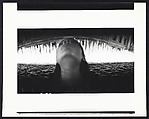Light Prop for an Electric Stage (Light-Space Modulator)
László Moholy-Nagy American, born Hungary
Not on view
László Moholy-Nagy played a key role at the Bauhaus in both Weimar and Dessau from 1923 to 1928, and at the New Bauhaus (later the Institute of Design) in Chicago from 1937 until his death in 1946. His major contribution to avant-garde photography was the New Vision (das neue Sehen), in which he advocated a new approach to the medium, proposing the use of such techniques as the manipulation of light in cameraless photograms, negative prints, sharply angled points of view, and radical cropping.
In this closely cropped photograph, Moholy-Nagy captures two technicians installing his sculpture, Light Prop for an Electric Stage (Light-Space Modulator). One of the earliest electrically powered kinetic sculptures, Light Prop was created with the assistance of an engineer and a metalsmith. The rotating construction, now in the collection of the Busch-Reisinger Museum at Harvard University, produces a startling array of visual effects when its reflective surfaces interact with a beam of light. Moholy-Nagy documented the sculpture in a series of still photographs, including this one, as well as recording it in motion in a short film, Light Display in Black and White (1930).
This image cannot be enlarged, viewed at full screen, or downloaded.

